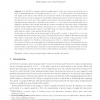33 search results - page 6 / 7 » Game chromatic number of Cartesian product graphs |
SIAMDM
2008
13 years 5 months ago
2008
The power system monitoring problem asks for as few as possible measurement devices to be put in an electric power system. The problem has a graph theory model involving power dom...
JGT
2010
13 years 3 months ago
2010
Let G(V, E) be a simple, undirected graph where V is the set of vertices and E is the set of edges. A b-dimensional cube is a Cartesian product I1 × I2 × · · · × Ib, where ea...
STOC
1993
ACM
13 years 9 months ago
1993
ACM
We consider a class of routing problems on connected graphs G. Initially, each vertex v of G is occupied by a “pebble” which has a unique destination π(v) in G (so that π is...
ICALP
2011
Springer
12 years 8 months ago
2011
Springer
In [13], Erd˝os et al. defined the local chromatic number of a graph as the minimum number of colors that must appear within distance 1 of a vertex. For any ∆ ≥ 2, there are ...
WG
2010
Springer
13 years 3 months ago
2010
Springer
book Author Title 58 Bijo S Anand Atoms and clique separators in graph products 59 Asir T Domination in total graph of a commutative ring 60 Sharada B On the Neighbourhood Subdivi...



